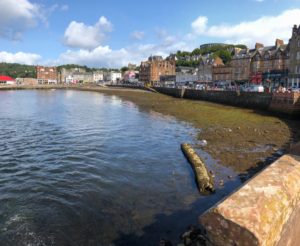
Oban is a young town by Scottish standards.
Even St. Columba’s Cathedral, which initially grabbed my attention, was built in 1959.
Our ship would only be anchored in the bay from 9:00 a.m. to 3:30 p.m., so we ate breakfast and headed into town in the morning to see what there was to see.
Being the only representative of the male of the species in the group, and having heard, “Oh that’s cute,” and “How does this look?” enough for one trip, after about fifteen minutes in Oban, I decided to set out on my own.
It didn’t take but an hour to see what there was to see in this port town.That’s not to say it is not a nice little Scottish town, but we are of course interested in Kingdom history.
Something that looms large over Scotland and its islands from an historical perspective is the influence of the Picts and the Vikings. The Picts are the ancient people who populated what is today Scotland. They were here when the Romans arrived. Even the Romans, perhaps the greatest military force that had listed to that time, could not defeat them. They finally resigned themselves to building a wall—two walls in fact—across the northern part of what is now England and in Scotland to keep the Picts out. It wasn’t until Columba brought the Gospel to the Picts that it was no longer necessary to war with them.
The Vikings were a similar story. They were also a warring people. They gained their wealth by raiding towns, monasteries, and settlements from Paris to Ireland. When, one day in 793 A.D., the monks at Lindisfarne saw ships approaching from the east they went out on the beach to welcome the strangers. In response, the Vikings killed the monks, pillaged and destroyed the priory and church, and took the gold, silver, and other valuables. The Vikings did the same to Jarrow (Bede’s hometown) and Iona. This went on for nearly two hundred years.
The Vikings eventually invaded and took over most of what is today England and Scotland. The English kings tried paying off the Vikings, as did the Gauls in Paris, but the Vikings continued to raid, steal, and kill. Nothing worked. Interestingly, the Vikings were taught that if they died in battle with a sword in their hand they would immediately go to Valhalla, their pagan heaven. It was not until the Vikings were converted to Christianity and joined the kingdom of God, that they began to build, rather than steal,k kill, and destroy.
History is a harsh teacher. But it is even harsher if its lessons are ignored. Islamic terrorism will not be subdued by military might or technology nor will Islam go the way of Pictish or Viking paganism because they are preached democratic capitalism or liberal western values.
Like the Vikings, militant Muslims are taught they will go straight to heaven if they die while carrying out Jihad. My guess is both religions come from the same source. Conversely, Kingdom citizens (and hence the Kingdom) overcome by the blood of the Lamb, the word of their testimony, and not loving their lives, even unto death. It was those Kingdom citizens who risked their lives to take the Gospel to the Picts and Vikings who ultimately defeated them for the kingdom of God. If we could only learn from history. GS
